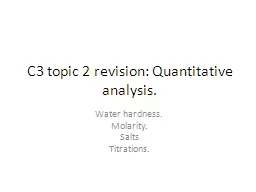

Water hardness Molarity Salts Titrations Water hardness Which ions make water hard How can we test for water hardness How can we remove temporary hardness How can we remove permanent hardness ID: 916482
Download Presentation The PPT/PDF document "C3 topic 2 revision: Quantitative analy..." is the property of its rightful owner. Permission is granted to download and print the materials on this web site for personal, non-commercial use only, and to display it on your personal computer provided you do not modify the materials and that you retain all copyright notices contained in the materials. By downloading content from our website, you accept the terms of this agreement.
Slide1
C3 topic 2 revision: Quantitative analysis.
Water hardness.
Molarity
.
Salts
Titrations.
Slide2Water hardness
Which ions make water hard?
How can we test for water hardness?
How can we remove temporary hardness?
How can we remove permanent hardness?
What do we need to do once all the Na
+
is used up?
Why don’t we use this method to remove temporary hardness?
Slide3Temporary hardness
This can be removed by boiling.
Caused by
limescale
(the product of magnesium and calcium ion decomposition)Removing the ions makes the water soft so it will lather.
Slide4Removing hardness.
Slide5Concentration
Slide6Slide7Converting
You may also need to know that ...
mole conc. (mol/dm
3
) x formula mass = mass concentration (g/dm
3
)
mass conc. (g/dm
3
) / formula mass = mole concentration (mol/dm
3
)
Slide8Slide9What is the mass concentration of sodium chloride (NaCl
) in g/dm
3
in a 1.50 mol/dm
3
solution? At. masses: Na = 23,
Cl
= 35.5, formula mass
NaCl
= 23 + 35.5 = 58.5
mass conc. = mol conc. x formula mass
Mass conc. In g/dm
3
= 1.50 x 58.5
= 87.8 g/dm
3
Questions
Slide10A solution of calcium sulphate (CaSO
4
) contained 0.500g dissolved in 2.00 dm
3
of water.
Calculate the concentration in (a) g/dm
3
and (b) mol/dm
3
.
(a)
concentration
= 0.500/2.00
= 0.250
g/dm
3
(b)
At. masses: Ca = 40, S = 32, O = 64, f. mass CaSO
4
= 40 + 32 + (4 x 16) = 136
moles CaSO
4
= 0.5 / 136 = 0.00368 mol
concentration CaSO
4
= 0.00368 / 2 =
0.00184 mol/dm
3
Slide11Making soluble salts (1)
Slide12Method 2
Which indicator to use?
Methyl orange: strong acid / weak alkali
Phenolphthalein: weak acid / strong alkali
We usually use methyl orange in titrations as the colour change from orange to pink is easier to see.
Slide13Concentration =
no. of moles
volume
Learn
this formula triangle!
m
c
v
number of moles
concentration (in
mol
dm
-3
)
volume (in dm
3
)
Slide14Titration calculations cont.
In a titration, 20 cm
3
of 2.0 mol dm
-3
HCl reacted with 25 cm3 of
NaOH
. What was the concentration of the sodium hydroxide
?
In a titration, 20 cm
3
of 0.2 mol dm
-3
HCl
reacted with 50 cm
3
of
NaOH
. What was the concentration of the sodium hydroxide?
Slide15Titration calculations cont.
In a titration, 20 cm
3
of 1.0 mol dm
-3
sulphuric acid, H2SO4
, reacted with 25 cm
3
of
NaOH. What was the concentration of the sodium hydroxide
?
In a titration, 20 cm
3
of 1.0 mol dm
-3
nitric acid, HNO
3
, reacted with 25 cm
3
of
NaOH
. What was the concentration of the sodium hydroxide?